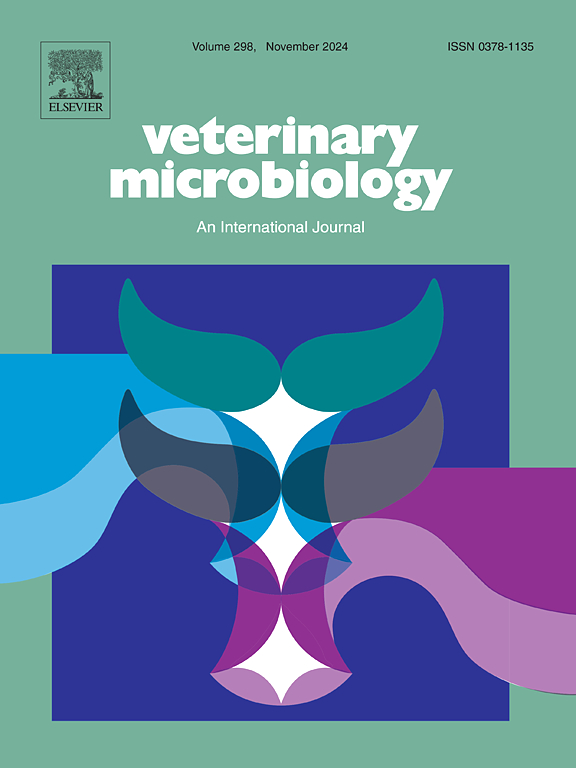Chlamydia psittaci infection induces IFN-I and IL-1β through the cGAS-STING-IRF3/NLRP3 pathway via mitochondrial oxidative stress in human macrophages
IF 2.4
2区 农林科学
Q3 MICROBIOLOGY
引用次数: 0
Abstract
Chlamydia psittaci (C. psittaci) is a multi-host pathogen that elicits robust innate immune responses in macrophages. Chlamydiae target host mitochondria to manipulate the cellular fate and metabolic functions. However, the effect of C. psittaci on the host mitochondria remains obscure. This study investigated how C. psittaci, post-infection in human macrophages, induces mitochondrial oxidative stress and damage to activate the cGAS-STING-IRF3/NLRP3 pathway for IFN-I and IL-1β production. Results demonstrate that C. psittaci increased mitochondrial ROS (mtROS) production. This induced the release of oxidized mitochondrial DNA (mtDNA) into the cytoplasm of macrophages. It also augmented IFN-I and IL-1β production dependent on the cGAS-STING pathway. Macrophages pre-treated with mtROS inhibitor mito-TEMPO displayed reduced oxidized mtDNA. This consequently lowered IFN-I and IL-1β production via the cGAS-STING pathway induced by C. psittaci. Additionally, we found that mtROS production may inhibit C. psittaci proliferation through the synergistic action of IFN-I and IL-1β. In conclusion, our study reveals that C. psittaci induces mtROS production leading to mtDNA release. This activates the cGAS-STING-IRF3/NLRP3 pathway to increase IFN-I and IL-1β production. This study elucidates a novel mechanism of bacterial pathogen activation in the cGAS-STING pathway. This reveals the molecular mechanisms underlying the immune response to C. psittaci infection and proposes potential targets for the treatment of C. psittaci related diseases.
鹦鹉热衣原体感染通过线粒体氧化应激在人巨噬细胞中通过 cGAS-STING-IRF3/NLRP3 途径诱导 IFN-I 和 IL-1β
鹦鹉热衣原体(C. psittaci)是一种多宿主病原体,可引起巨噬细胞强烈的先天性免疫反应。衣原体以宿主线粒体为目标,操纵细胞的命运和代谢功能。然而,鹦鹉热衣原体对宿主线粒体的影响仍不明显。本研究调查了人巨噬细胞感染 C. psittaci 后如何诱导线粒体氧化应激和损伤,从而激活 cGAS-STING-IRF3/NLRP3 通路,产生 IFN-I 和 IL-1β。结果表明,鹦鹉热杆菌增加了线粒体 ROS(mtROS)的产生。这诱导氧化线粒体 DNA(mtDNA)释放到巨噬细胞的细胞质中。它还增强了依赖于 cGAS-STING 通路的 IFN-I 和 IL-1β 的产生。经 mtROS 抑制剂 mito-TEMPO 预处理的巨噬细胞显示出氧化的 mtDNA 减少。这就降低了猫疫病通过 cGAS-STING 途径诱导的 IFN-I 和 IL-1β 的产生。此外,我们还发现,mtROS 的产生可通过 IFN-I 和 IL-1β 的协同作用抑制鹦鹉热杆菌的增殖。总之,我们的研究揭示了鹦鹉热嗜血杆菌会诱导 mtROS 的产生,从而导致 mtDNA 的释放。这激活了 cGAS-STING-IRF3/NLRP3 通路,增加了 IFN-I 和 IL-1β 的产生。这项研究阐明了细菌病原体在 cGAS-STING 通路中被激活的新机制。这揭示了猫疫病感染免疫反应的分子机制,并提出了治疗猫疫病相关疾病的潜在靶点。
本文章由计算机程序翻译,如有差异,请以英文原文为准。
求助全文
约1分钟内获得全文
求助全文
来源期刊

Veterinary microbiology
农林科学-兽医学
CiteScore
5.90
自引率
6.10%
发文量
221
审稿时长
52 days
期刊介绍:
Veterinary Microbiology is concerned with microbial (bacterial, fungal, viral) diseases of domesticated vertebrate animals (livestock, companion animals, fur-bearing animals, game, poultry, fish) that supply food, other useful products or companionship. In addition, Microbial diseases of wild animals living in captivity, or as members of the feral fauna will also be considered if the infections are of interest because of their interrelation with humans (zoonoses) and/or domestic animals. Studies of antimicrobial resistance are also included, provided that the results represent a substantial advance in knowledge. Authors are strongly encouraged to read - prior to submission - the Editorials (''Scope or cope'' and ''Scope or cope II'') published previously in the journal. The Editors reserve the right to suggest submission to another journal for those papers which they feel would be more appropriate for consideration by that journal.
Original research papers of high quality and novelty on aspects of control, host response, molecular biology, pathogenesis, prevention, and treatment of microbial diseases of animals are published. Papers dealing primarily with immunology, epidemiology, molecular biology and antiviral or microbial agents will only be considered if they demonstrate a clear impact on a disease. Papers focusing solely on diagnostic techniques (such as another PCR protocol or ELISA) will not be published - focus should be on a microorganism and not on a particular technique. Papers only reporting microbial sequences, transcriptomics data, or proteomics data will not be considered unless the results represent a substantial advance in knowledge.
Drug trial papers will be considered if they have general application or significance. Papers on the identification of microorganisms will also be considered, but detailed taxonomic studies do not fall within the scope of the journal. Case reports will not be published, unless they have general application or contain novel aspects. Papers of geographically limited interest, which repeat what had been established elsewhere will not be considered. The readership of the journal is global.
 求助内容:
求助内容: 应助结果提醒方式:
应助结果提醒方式:


